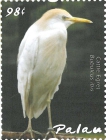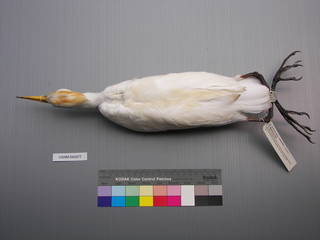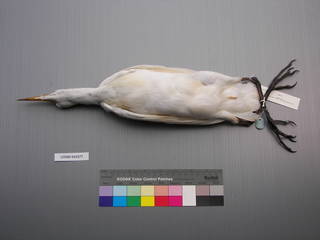WoRMS taxon details
Bubulcus ibis (Linnaeus, 1758)
159742 (urn:lsid:marinespecies.org:taxname:159742)
accepted
Species
Ardea ibis Linnaeus, 1758 · unaccepted
Ardeola ibis (Linnaeus, 1758) · unaccepted
Bubulcus coromandus (Boddaert, 1783) · unaccepted
Bubulcus ibis coromandus (Boddaert, 1783) · unaccepted
- Subspecies Bubulcus ibis coromandus (Boddaert, 1783) accepted as Bubulcus ibis (Linnaeus, 1758)
(of Ardea ibis Linnaeus, 1758) Linnaeus, C. (1758). Systema Naturae per regna tria naturae, secundum classes, ordines, genera, species, cum characteribus, differentiis, synonymis, locis. [The system of nature through the three kingdoms of nature, according to classes, orders, genera, species, with characters, differences, synonyms, places.]. <em>Impensis Direct. Laurentii Salvii. Holmiae [Stockholm].</em> 1(10) [iii], 824 p., available online at https://biodiversitylibrary.org/page/726886 [details] Available for editors  [request]
[request]
Description Length: 50-56 cm. Plumage: white in non- and white with buff plumes on crown, back and breast in breeding season. Immature...
Distribution North America
Taxonomy can obtain up to 50 % more food and use only two-thirds as much energy catching it by associating with cattle (perch on...
Description Length: 50-56 cm. Plumage: white in non- and white with buff plumes on crown, back and breast in breeding season. Immature like non-breeding adult. Bare parts: iris yellow, red in breeding birds; lores yellow, purplish pink in breeding birds; bill yellow, orange in breeding birds; feet and legs olive brown, dull orange in breeding birds. Habitat: generally pastures and cultivation, but roosts along creeks, estuaries and other water bodies. <388><393><391> [details]
Distribution North America
Distribution North America [details]
Taxonomy can obtain up to 50 % more food and use only two-thirds as much energy catching it by associating with cattle (perch on...
Taxonomy can obtain up to 50 % more food and use only two-thirds as much energy catching it by associating with cattle (perch on theirs backs) [details]
WoRMS (2025). Bubulcus ibis (Linnaeus, 1758). Accessed at: https://www.marinespecies.org/aphia.php?p=taxdetails&id=159742 on 2025-07-15
Date
action
by
![]() The webpage text is licensed under a Creative Commons
Attribution 4.0 License
The webpage text is licensed under a Creative Commons
Attribution 4.0 License
Nomenclature
original description
(of Ardea ibis Linnaeus, 1758) Linnaeus, C. (1758). Systema Naturae per regna tria naturae, secundum classes, ordines, genera, species, cum characteribus, differentiis, synonymis, locis. [The system of nature through the three kingdoms of nature, according to classes, orders, genera, species, with characters, differences, synonyms, places.]. <em>Impensis Direct. Laurentii Salvii. Holmiae [Stockholm].</em> 1(10) [iii], 824 p., available online at https://biodiversitylibrary.org/page/726886 [details] Available for editors  [request]
[request]
basis of record Banks, R.C., R.W. McDiarmid, and A.L. Gardner. 1987. Checklist of vertebrates of the United States, the U.S. Territories, and Canada. U.S. Fish and Wildlife Service Resource Publication No. 166. 79 p. [details]
basis of record Banks, R.C., R.W. McDiarmid, and A.L. Gardner. 1987. Checklist of vertebrates of the United States, the U.S. Territories, and Canada. U.S. Fish and Wildlife Service Resource Publication No. 166. 79 p. [details]
Other
context source (Introduced species)
Molnar, J.L., R.L. Gamboa, C. Revenga & M.D. Spalding. (2008). Assessing the global threat of invasive species to marine biodiversity. <em>Frontiers in Ecology and the Environment.</em> 6(9): 485-492., available online at https://www.conservationgateway.org/ConservationPractices/Marine/Pages/marineinvasives.aspx [details] Available for editors  [request]
[request]
context source (Bermuda) Amos, E. J. R. (1991). A Guide to The Birds of Bermuda. 206 pp [details]
additional source Robbins, C. S. (1983). Golden field Guide to Birds of North America. Golden press. 360p. [details]
additional source Peterson, R.T.; Peterson, V.M. (2002). A field guide to the birds of eastern and central North America. <em>Fifth Edition.</em> Peterson Field Guide Series. Houghton Mifflin Company. New York. 427 p. [details]
additional source Squires, H. J. (1990). Decapod Crustacea of the Atlantic coast of Canada. <em>Canadian Bulletin of Fisheries and Aquatic Sciences.</em> 221: 532 p., available online at http://www.dfo-mpo.gc.ca/library/116743.pdf [details]
additional source Animal Diversity Web. <em>University of Michigan Museum of Zoology.</em> , available online at http://animaldiversity.ummz.umich.edu/site/index.html [details]
additional source Vanner, M. (2003). The encyclopedia of North American birds. <em>Paragon Publishing.</em> 1-383. [details]
additional source Brown, L.H., E.K. Urban & K. Newman. (1982). The Birds of Africa, Volume I. <em>Academic Press, London.</em> [details]
additional source Gallardo, J. C.; Macías, V.; Velarde, E. (2009). Birds (Vertebrata: Aves) of the Gulf of Mexico. <em>In: Felder, D.L. and D.K. Camp (eds.), Gulf of Mexico–Origins, Waters, and Biota. Biodiversity. Texas A&M Press, College Station, Texas.</em> Pp. 1321–1342. [details]
additional source Liu, J.Y. [Ruiyu] (ed.). (2008). Checklist of marine biota of China seas. <em>China Science Press.</em> 1267 pp. (look up in IMIS) [details] Available for editors [request]
[request]
additional source Integrated Taxonomic Information System (ITIS). , available online at http://www.itis.gov [details]
context source (Bermuda) Amos, E. J. R. (1991). A Guide to The Birds of Bermuda. 206 pp [details]
additional source Robbins, C. S. (1983). Golden field Guide to Birds of North America. Golden press. 360p. [details]
additional source Peterson, R.T.; Peterson, V.M. (2002). A field guide to the birds of eastern and central North America. <em>Fifth Edition.</em> Peterson Field Guide Series. Houghton Mifflin Company. New York. 427 p. [details]
additional source Squires, H. J. (1990). Decapod Crustacea of the Atlantic coast of Canada. <em>Canadian Bulletin of Fisheries and Aquatic Sciences.</em> 221: 532 p., available online at http://www.dfo-mpo.gc.ca/library/116743.pdf [details]
additional source Animal Diversity Web. <em>University of Michigan Museum of Zoology.</em> , available online at http://animaldiversity.ummz.umich.edu/site/index.html [details]
additional source Vanner, M. (2003). The encyclopedia of North American birds. <em>Paragon Publishing.</em> 1-383. [details]
additional source Brown, L.H., E.K. Urban & K. Newman. (1982). The Birds of Africa, Volume I. <em>Academic Press, London.</em> [details]
additional source Gallardo, J. C.; Macías, V.; Velarde, E. (2009). Birds (Vertebrata: Aves) of the Gulf of Mexico. <em>In: Felder, D.L. and D.K. Camp (eds.), Gulf of Mexico–Origins, Waters, and Biota. Biodiversity. Texas A&M Press, College Station, Texas.</em> Pp. 1321–1342. [details]
additional source Liu, J.Y. [Ruiyu] (ed.). (2008). Checklist of marine biota of China seas. <em>China Science Press.</em> 1267 pp. (look up in IMIS) [details] Available for editors
additional source Integrated Taxonomic Information System (ITIS). , available online at http://www.itis.gov [details]
 Present
Present  Present in aphia/obis/gbif/idigbio
Present in aphia/obis/gbif/idigbio  Inaccurate
Inaccurate  Introduced: alien
Introduced: alien  Containing type locality
Containing type locality
Unreviewed
Breeding Category Vagrant [details]Description Length: 50-56 cm. Plumage: white in non- and white with buff plumes on crown, back and breast in breeding season. Immature like non-breeding adult. Bare parts: iris yellow, red in breeding birds; lores yellow, purplish pink in breeding birds; bill yellow, orange in breeding birds; feet and legs olive brown, dull orange in breeding birds. Habitat: generally pastures and cultivation, but roosts along creeks, estuaries and other water bodies. <388><393><391> [details]
Diet active insects (grasshoppers, crickets, spiders, flies, moths) and frogs [details]
Dimensions Length: 20" (51 cm); Wingspan: 36" (91 cm) [details]
Distribution North America [details]
Habitat mostly terrestrial but is also well adapted to aquatic habitat [details]
IUCN Red List Category Least Concern [details]
Importance some ranchers rely on these birds for fly control more than they do pesticides [details]
Taxonomy can obtain up to 50 % more food and use only two-thirds as much energy catching it by associating with cattle (perch on theirs backs) [details]
| Language | Name | |
|---|---|---|
| Bulgarian | Биволска чапла | [details] |
| Danish | kohejre | [details] |
| Dutch | koereiger | [details] |
| English | western cattle egretcattle egretbuff-backed heron | [details] |
| German | Kuhreiher | [details] |
| Hebrew | אנפית סוף | [details] |
| Lithuanian | ibiškasis garnys | [details] |
| Modern Greek (1453-) | Γελαδάρης | [details] |
| Norwegian Bokmål | kuhegre | [details] |
| Norwegian Nynorsk | kuhegre | [details] |
| Polish | czapla złotawa | [details] |
| Romanian | stârcul de cireadă | [details] |
| Russian | цапля египетская | [details] |
| Slovenian | kravja čaplja | [details] |
| Spanish | garcilla bueyera | [details] |
| Swedish | kohäger | [details] |
| Turkish | sığır balıkçılısigir balikcil | [details] |
| Ukrainian | Чапля єгипетська | [details] |
| Welsh | crëyr y gwartheg | [details] |
To Barcode of Life (49 barcodes)
To Biodiversity Heritage Library (250 publications)
To Biodiversity Heritage Library (73 publications) (from synonym Ardea ibis Linnaeus, 1758)
To European Nucleotide Archive, ENA (Bubulcus ibis)
To GenBank (667 nucleotides; 312 proteins)
To GenBank (667 nucleotides; 312 proteins) (from synonym Ardea ibis Linnaeus, 1758)
To Global Invasive Species Database (GISD)
To IUCN Red List (Least Concern)
To NMNH Extant Collection (USNM 643577 Dorsal)
To NMNH Extant Collection (USNM 643577 Ventral)
To PESI
To ITIS
To Biodiversity Heritage Library (250 publications)
To Biodiversity Heritage Library (73 publications) (from synonym Ardea ibis Linnaeus, 1758)
To European Nucleotide Archive, ENA (Bubulcus ibis)
To GenBank (667 nucleotides; 312 proteins)
To GenBank (667 nucleotides; 312 proteins) (from synonym Ardea ibis Linnaeus, 1758)
To Global Invasive Species Database (GISD)
To IUCN Red List (Least Concern)
To NMNH Extant Collection (USNM 643577 Dorsal)
To NMNH Extant Collection (USNM 643577 Ventral)
To PESI
To ITIS







